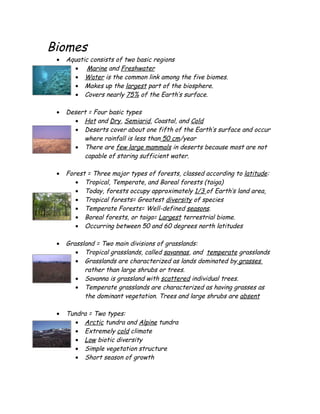
Suplamental Student Notes With Answers
- 1. Biomes • Aquatic consists of two basic regions • Marine and Freshwater • Water is the common link among the five biomes. • Makes up the largest part of the biosphere. • Covers nearly 75% of the Earth’s surface. • Desert = Four basic types • Hot and Dry, Semiarid, Coastal, and Cold • Deserts cover about one fifth of the Earth’s surface and occur where rainfall is less than 50 cm/year • There are few large mammals in deserts because most are not capable of storing sufficient water. • Forest = Three major types of forests, classed according to latitude: • Tropical, Temperate, and Boreal forests (taiga) • Today, forests occupy approximately 1/3 of Earth’s land area, • Tropical forests= Greatest diversity of species • Temperate Forests= Well-defined seasons. • Boreal forests, or taiga= Largest terrestrial biome. • Occurring between 50 and 60 degrees north latitudes • Grassland = Two main divisions of grasslands: • Tropical grasslands, called savannas, and temperate grasslands • Grasslands are characterized as lands dominated by grasses rather than large shrubs or trees. • Savanna is grassland with scattered individual trees. • Temperate grasslands are characterized as having grasses as the dominant vegetation. Trees and large shrubs are absent • Tundra = Two types: • Arctic tundra and Alpine tundra • Extremely cold climate • Low biotic diversity • Simple vegetation structure • Short season of growth
- 2. How does the atmosphere affect weather? • The atmosphere is a mixture of gases that surrounds the Earth • Has five different layers; each has different properties • Air Temperature and Pressure change with altitude • Weather occurs in the layer closest to Earth (troposphere) Air Masses • body of air with a certain temperature and moisture level Fronts • Places where air masses meet • 4 Types: Warm, Cold, Occluded, Stationary • Each kind can bring different kinds of weather
- 3. Relative Humidity Measure of the amount of moisture in the air compared to what the air could hold How “full” of water the air is Expressed as % 100% relative humidity = saturated air Controlled by temperature 1. Warm air holds more moisture than cool air (more space for water vapor between air molecules) 2. As air warms, relative humidity decreases 3. As air cools, relative humidity increases Dew Point =Temperature at which the air is saturated (100% relative humidity) Several events can occur when the dew point temp. is reached: 1. If dew point temp is above freezing: a. water vapor condenses as liquid b. dew will form on surfaces c. cloud droplets will form in air 2. If dew point temp. is below freezing: a. water vapor condenses as a solid b. frost on surfaces c. snow (or hail) in the air Rainbows Caused by sunshine on raindrops White light (all colors) is refracted (bent) into colors as it enters and exits the drop To see a rainbow you must have the sun behind you and raindrops in the air
- 4. Thunderstorms: Requires a mature cumulonimbus cloud Signs a. Sudden reversal of wind direction b. Noticeable increase in wind speed c. Sudden drop in temperature Possible weather: a. heavy rains (flash floods) b. lightning (forest fires) c. thunder (frightens animals) d. hail (crop damage) e. tornadoes f. strong, gusty winds Lightning Storm: • Lightning stroke: flow of current thru air (a poor conductor) from the – to the + • Lightning can flow from cloud to ground, cloud to cloud, and from ground to cloud • Bright light is caused by glowing air molecules heated by the current • Lightning follows the path of least resistance (easiest way to positive) • Lightning rod offers lightning an easy, safe path to the ground (+) Thunder is the shock wave caused by the explosive expansion of heated air • Sound travels @ about 1100 ft/sec in air • 5,280 ft in one mile • Distance from you to lightning = number of seconds between seeing the flash and hearing the thunder divided by 5. (5,280 ft / 1100 ft/sec = 5 seconds)
- 5. Tornado: • Tornadoes that form over water are called “waterspouts” • Typical tornado will: 1. Occur between 3-7 pm 2. Travel 4 miles 3. Be 300-400 m wide 4. Travel 25-40 mi/hour 5. Have wind speeds up to 300 mi/hr 6. Produce extremely low pressure 7. Be dark due to debris picked up Tropical Cyclone • Also Known As: 1. Atlantic: hurricane 2. SE Asia, Japan: typhoon 3. Australia: willy-willy 4. Indian Ocean: cyclone • Rated by wind speed (category 1 to 5) • Starts and grows over warm ocean water • Composed of bands of thunderstorms spiraling counterclockwise around a low pressure center • Several hundred miles wide • Last many days (even weeks) • Winds from 74-200 mi/hr • Contains an “eye” • Small region of low pressure • Surrounded by highest winds • Calm, peaceful, sunny weather • Last for about 1 hour as hurricane passes by